Abstract
Taylor, W. Herman (Portland State College, Portland, Ore.), and Mary L. Taylor. Enzymes of the pyrimidine pathway in Escherichia coli. II. Intracellular localization and properties of dihydroorotic dehydrogenase. J. Bacteriol. 88:105–111. 1964.—Intracellular localization of three enzymes of the pyrimidine pathway in Escherichia coli was studied. Dihydroorotic dehydrogenase was found to be associated with the membrane portion of lysed spheroplasts. Centrifugal fractionation of cell-free extracts showed all the dihydroorotic dehydrogenase activity to be associated with large structures, probably cell wall-membrane fragments. In contrast, all orotidylic decarboxylase activity was found in the cytoplasm in both lysed spheroplasts and cell-free extracts. Aspartate transcarbamylase activity appeared to be particulate in repressed cells, but only 25% was particulate in derepressed cells. Dihydroorotic dehydrogenase was shown to be bound to oxidative particles by oxygen uptake and orotate production from dihydroorotate. A ferricyanide reduction assay, suitable for measuring soluble and particulate enzyme, was devised for dihydroorotic dehydrogenase. Soluble dihydroorotic dehydrogenase was prepared by use of deoxycholate. A 20-fold purification of the enzyme compared to whole-cell activity was achieved by ammonium sulfate fractionation of the deoxycholate-soluble enzyme. Although cytochromes were implicated by cyanide inhibition of aerobic orotate production by particles, the purified enzyme appeared to be separated from the cytochromes, as shown by lack of cyanide inhibition in the ferricyanide assay. The purified soluble enzyme did not react in the aerobic assay previously used by others for assay of this enzyme. In contrast to the degradative dihydroorotic dehydrogenases reported by other workers, the biosynthetic dihydroorotic dehydrogenase of E. coli did not link to pyridine nucleotides.
Full text
PDF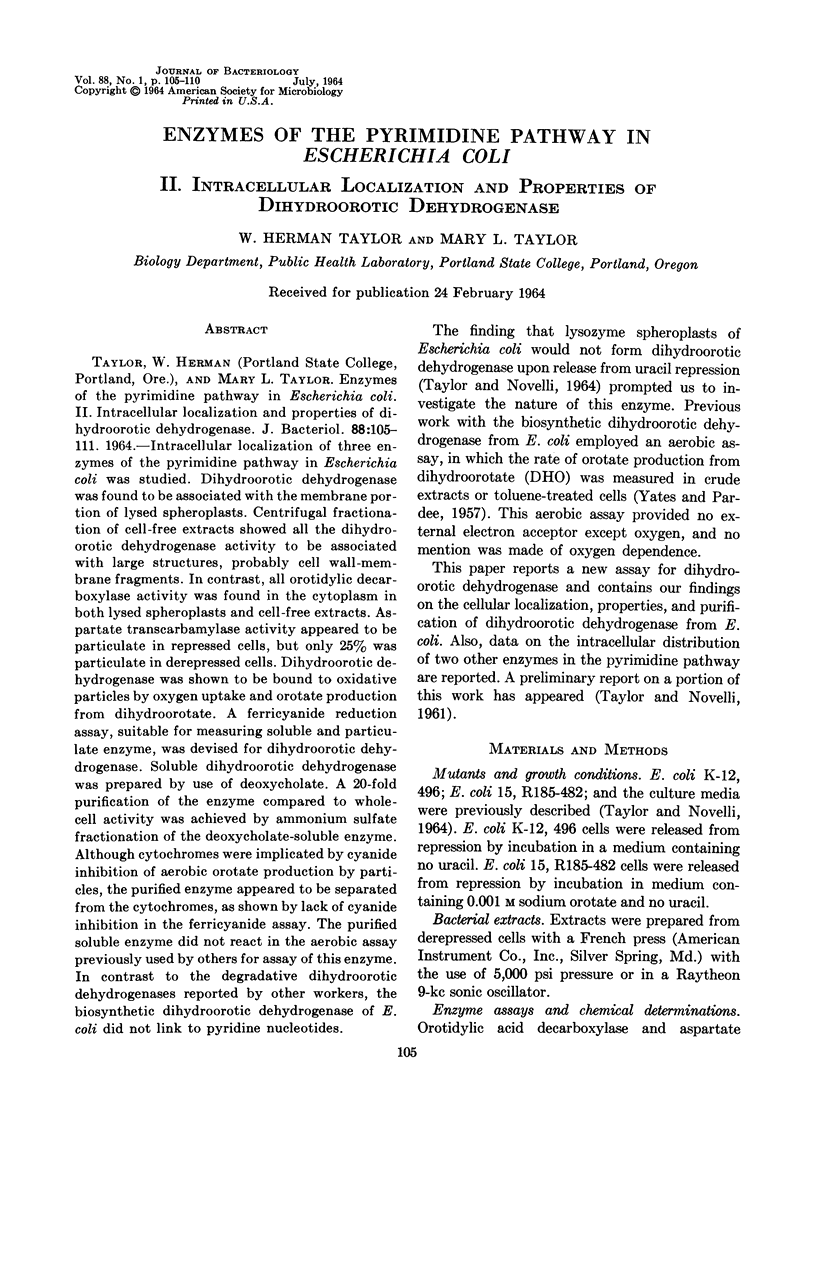
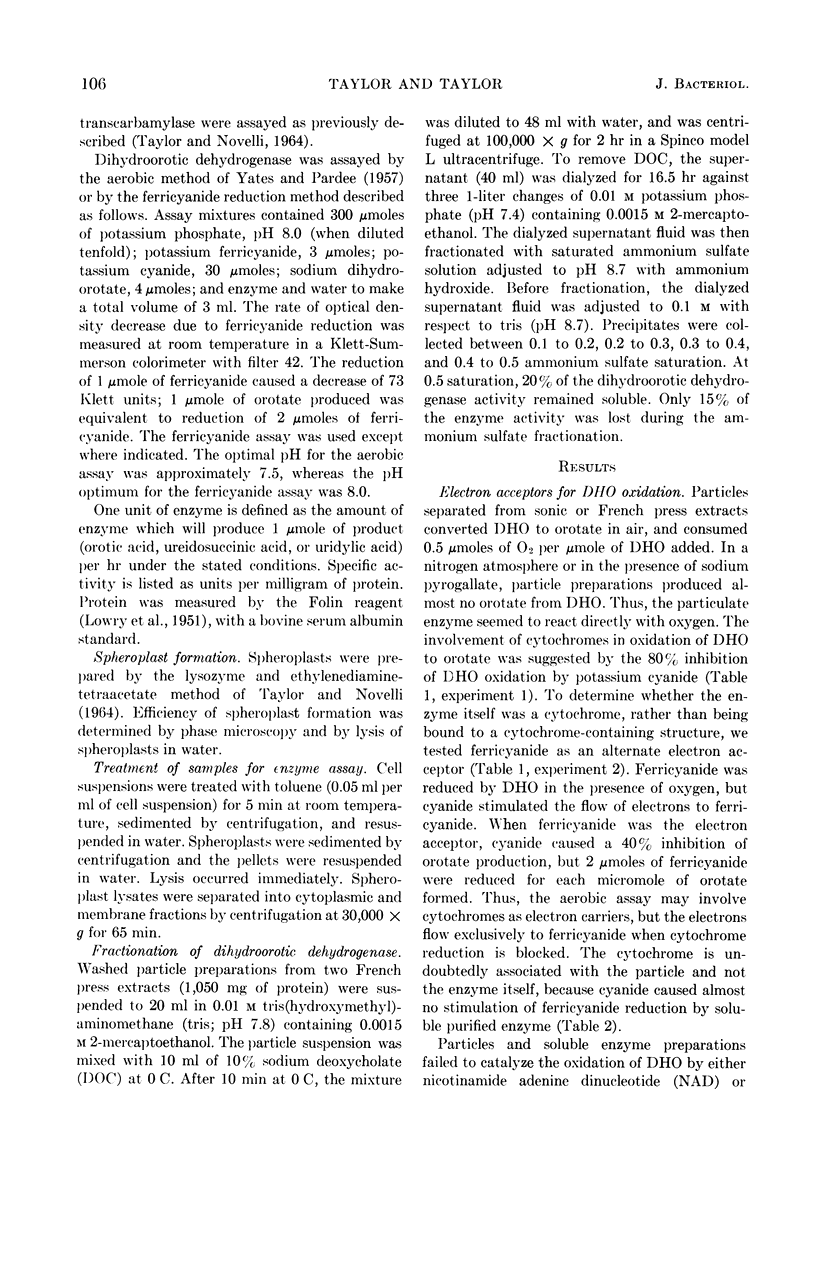

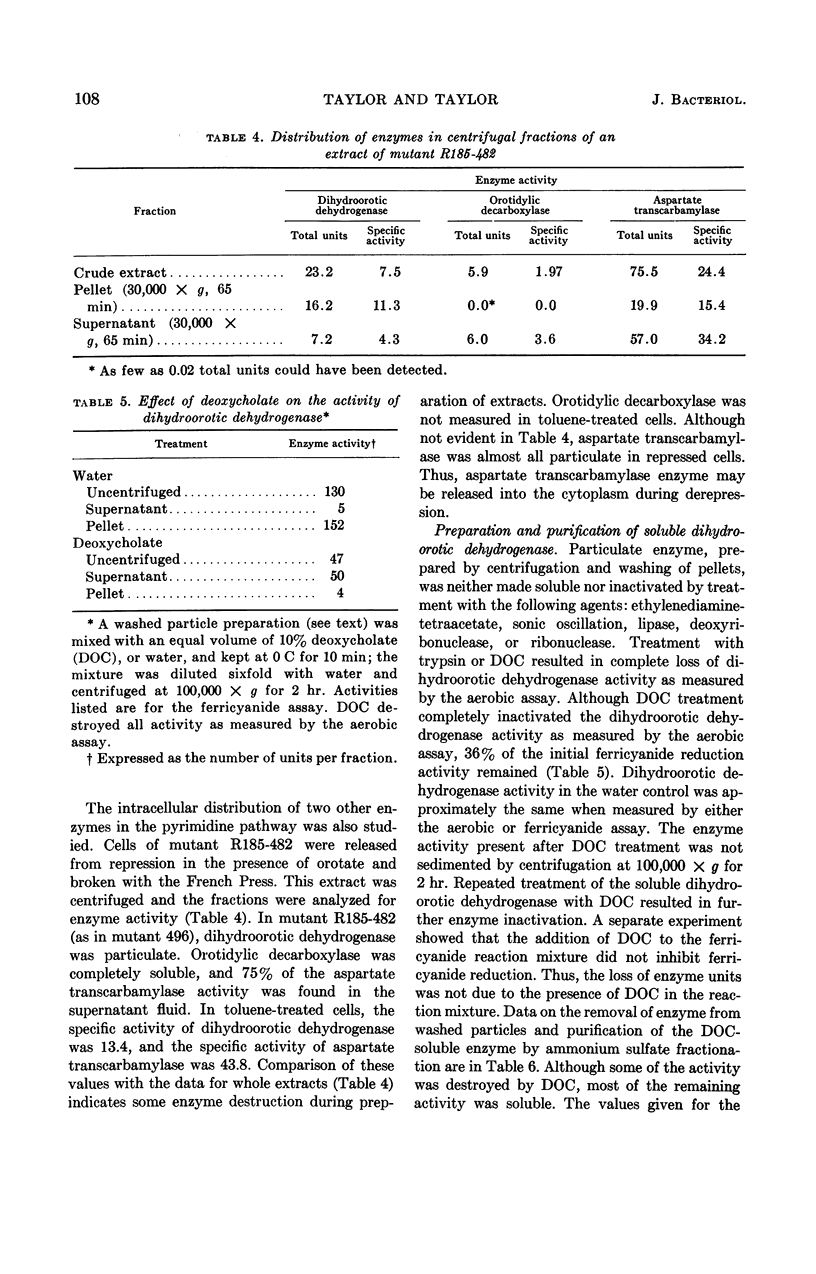
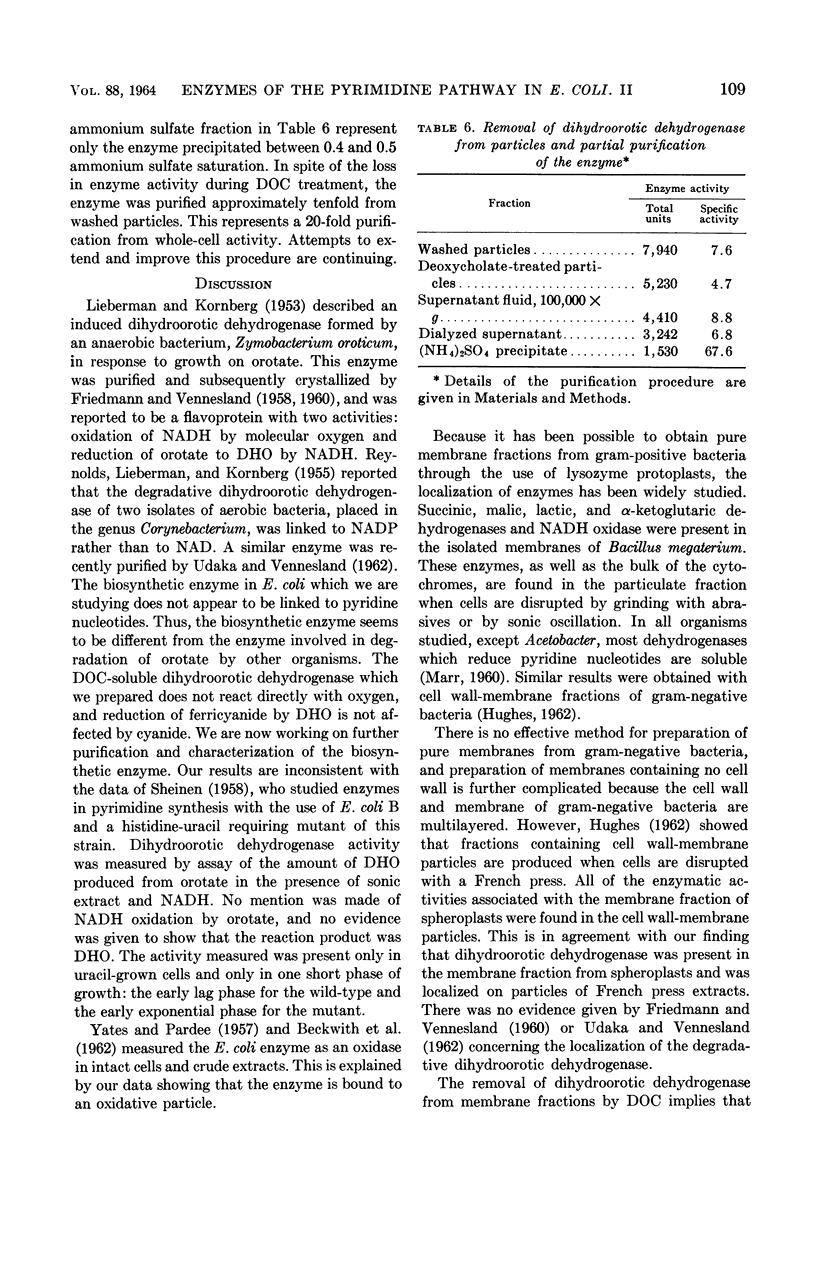
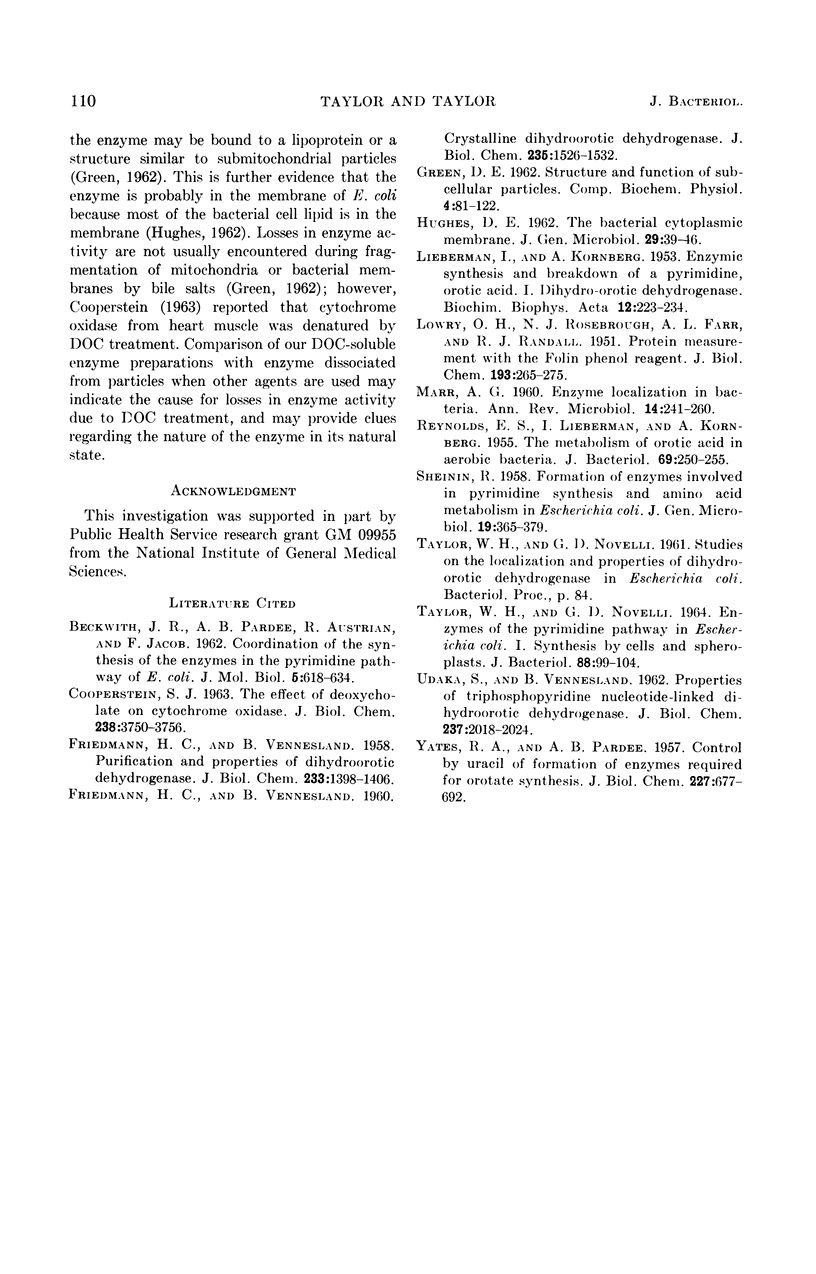
Selected References
These references are in PubMed. This may not be the complete list of references from this article.
- BECKWITH J. R., PARDEE A. B., AUSTRIAN R., JACOB F. Coordination of the synthesis of the enzymes in the pyrimidine pathway of E. coli. J Mol Biol. 1962 Dec;5:618–634. doi: 10.1016/s0022-2836(62)80090-4. [DOI] [PubMed] [Google Scholar]
- COOPERSTEIN S. J. THE EFFECT OF DEOXYCHOLATE ON CYTOCHROME OXIDASE. J Biol Chem. 1963 Nov;238:3750–3756. [PubMed] [Google Scholar]
- FRIEDMANN H. C., VENNESLAND B. Crystalline dihydroorotic dehydrogenase. J Biol Chem. 1960 May;235:1526–1532. [PubMed] [Google Scholar]
- FRIEDMANN H. C., VENNESLAND B. Purification and properties of dihydro-orotic dehydrogenase. J Biol Chem. 1958 Dec;233(6):1398–1406. [PubMed] [Google Scholar]
- GREEN D. E. Structure and function of subcellular particles. Comp Biochem Physiol. 1962 Oct;4:81–122. doi: 10.1016/0010-406x(62)90001-4. [DOI] [PubMed] [Google Scholar]
- HUGHES D. E. The bacterial cytoplasmic membrane. J Gen Microbiol. 1962 Sep;29:39–46. doi: 10.1099/00221287-29-1-39. [DOI] [PubMed] [Google Scholar]
- LIEBERMAN I., KORNBERG A. Enzymic synthesis and breakdown of a pyrimidine, orotic acid. I. Dihydro-orotic dehydrogenase. Biochim Biophys Acta. 1953 Sep-Oct;12(1-2):223–234. doi: 10.1016/0006-3002(53)90141-3. [DOI] [PubMed] [Google Scholar]
- LOWRY O. H., ROSEBROUGH N. J., FARR A. L., RANDALL R. J. Protein measurement with the Folin phenol reagent. J Biol Chem. 1951 Nov;193(1):265–275. [PubMed] [Google Scholar]
- MARR A. G. Enzyme localization in bacteria. Annu Rev Microbiol. 1960;14:241–260. doi: 10.1146/annurev.mi.14.100160.001325. [DOI] [PubMed] [Google Scholar]
- REYNOLDS E. S., LIEBERMAN I., KORNBERG A. The metabolism of orotic acid in aerobic bacteria. J Bacteriol. 1955 Mar;69(3):250–255. doi: 10.1128/jb.69.3.250-255.1955. [DOI] [PMC free article] [PubMed] [Google Scholar]
- SHEININ R. Formation of enzymes involved in pyrimidine synthesis and amino acid metabolism in Escherichia coli. J Gen Microbiol. 1958 Oct;19(2):365–379. doi: 10.1099/00221287-19-2-365. [DOI] [PubMed] [Google Scholar]
- TAYLOR W. H., NOVELLI G. D. ENZYMES OF THE PYRIMIDINE PATHWAY IN ESCHERICHIA COLI. I. SYNTHESIS BY CELLS AND SPHEROPLASTS. J Bacteriol. 1964 Jul;88:99–104. doi: 10.1128/jb.88.1.99-104.1964. [DOI] [PMC free article] [PubMed] [Google Scholar]
- UDAKA S., VENNESLAND B. Properties of triphosphopyridine nucleotide-linked dihydroorotic dehydrogenase. J Biol Chem. 1962 Jun;237:2018–2024. [PubMed] [Google Scholar]
- YATES R. A., PARDEE A. B. Control by uracil of formation of enzymes required for orotate synthesis. J Biol Chem. 1957 Aug;227(2):677–692. [PubMed] [Google Scholar]


